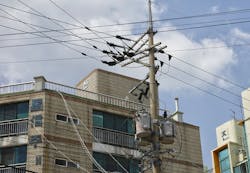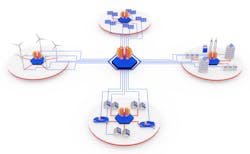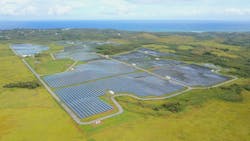Grid Control Steadies Renewables in Storms
When Hurricane Ida made landfall in Louisiana in August 2021, the storm forged a path of destruction and tragedy across much of the eastern U.S. Nearly 100 people lost their lives, and the storm left behind tens of billions of dollars of damage by the time it dissipated. Thankfully, the city of New Orleans, Louisiana, was spared from widespread damage, as the improved levee system encircling the city held. Though the city avoided catastrophic flooding, it did not avoid damage altogether. The powerful storm wiped out much of the region’s transmission lines, disconnecting communities from sources of power. Greater New Orleans was left in the dark for days, while more isolated towns in southern Louisiana went without power for much longer. Coming on the heels of the Pacific Northwest Heat Dome and a February winter storm in Texas, Hurricane Ida became yet another destructive weather event illustrating the need for modern grid solutions.
Microgrids and the software to manage them can be an effective way to help keep communities connected to power during destructive weather. Microgrids that serve neighborhoods, critical buildings or small towns can continue delivering power if transmission lines connecting municipal grids to traditional sources of power, like large fossil fuel power plants, fail. Using grid controls, utilities easily can balance power between renewable energy sources and fossil fuel sources, while also continuing to keep communities on-line in the event of a major grid failure. Microgrids are even more beneficial for isolated communities far from power sources and the resources needed to repair downed lines.
What is beneficial about microgrids and modern grid control technology? The technology already exists, does not require major infrastructure upgrades and is a proven solution. Software-based grid controls are an easy and efficient installation that enable utility engineers to balance power between various sources. These software controls — including microgrid controllers, renewable power plant controllers and distributed energy resource management systems (DERMS) — can help communities to onboard renewables without sacrificing power quality.
The intermittent nature of solar and wind power can be offset by energy storage, and grid control software can execute the rapid-fire commands required to balance power generation and storage efficiently. A couple examples where these combined renewable power-battery storage solutions have been enacted include the island of Guam and Jeju Island in South Korea.
Guam’s Grid
Guam’s 168,000 residents are spread out over the 200-sq mile (518-sq km) western Pacific island. The Guam Power Authority (GPA), a public corporation, provides electricity throughout the island. GPA’s electric grid includes about 1800 miles (2897 km) of T&D lines with a load of about 200 MW. Several factors make power generation on the island challenging. Lacking any fossil fuel sources of its own, Guam must import petroleum to meet its current energy needs. When severe weather or other catastrophic events disrupt petroleum imports, the island’s power plants are in trouble. This heightens the urgency for Guam to transition to domestic renewable energy. The island’s goal is to have 100% renewable energy by 2045. In addition to petroleum-based power plants, Guam has a 25-MW photovoltaic farm. Guamanian customers also may contribute homegrown solar and renewables, and they are paid by GPA for their excess, which is distributed across the grid.
A large U.S. military presence on the island adds to Guam’s unique power demands. The military accounts for about one-fifth of Guam’s power consumption, and this may increase with the U.S. government’s plans to relocate military personnel from the islands of Okinawa to Guam in 2024. With total power demand on Guam set to rise, the island needed to integrate more renewables onto its grid to meet its clean energy goals.
When Guam’s solar farm came on-line in 2015, it helped to reduce reliance on fossil fuels but created grid instability issues because of the variations in weather. Although the island has a relatively stable tropical marine climate, with temperatures throughout the year ranging from 70°F to 90°F (21°C to 32°C), it can experience extreme typhoons during the rainy season, from November through May. In 1997, Guam recorded one of the highest wind speeds on earth at 230 mph (370 kmph) during Super Typhoon Paka. Storms, clouds and other weather conditions mean Guam’s photovoltaics (PV) farm’s output ranges from 5 MW to 25 MW,
a significant fluctuation that was resulting in severe grid disturbances.
A Stabilizing Solution
Maintaining a stable grid is every utility’s top priority, and GPA sought a solution that would enable it to make the most of its solar generation during the rainy season. To mitigate both power and grid frequency fluctuations, the GPA commissioned energy storage systems from LG CNS, a major subsidiary of LG Corp. that specializes in large-scale IT solutions. Two utility-scale batteries were procured from LG Chem: one battery to mitigate solar fluctuation and the other to provide active frequency support.
GPA tapped PXiSE Energy Solutions to deploy its real-time controller in the capital of Agana, to control LG Chem’s 24-MW, 6-MWh battery energy storage system (BESS). Through a closed-loop system, the controller provides active frequency control in real time, with a 50-msec response time to control the frequency to 60 Hz, to within 0.1 Hz, even with dramatic dips and flares in power output and usage. It also effectively manages the battery to act as a spinning reserve, reducing reliance on fossil fuel generators.
PXiSE deployed a second real-time controller in Talofofo, connecting the 25-MW solar PV farm and LG Chem’s 16-MW, 16-MWh BESS, which are about 5 miles (8 km) apart. This controller is charged with mitigating solar PV intermittency, which it does by managing a tight 250-kW/min (1%) ramp rate and a response time of less than 50 msec.
The combined system is scalable, reliable and safe. As assets grow, the system can expand horizontally and vertically. PXiSE can deploy additional controllers and aggregate them through a higher-level DERMS controller. Because the controllers are preconfigured with a wide range of communication protocols, adding more distributed energy resources is easy.
The deployment of the combined controller-renewables-storage system demonstrates how quickly an alternative to fossil fuels can be integrated for community power stability. The GPA and LG CNS had specific requirements for a controller, because of their need to accommodate grid fluctuations, and needed it to be deployed quickly — within six months. Though in Guam’s case deployment was delayed due to the pandemic and typhoon season, PXiSE typically installs grid controllers in four months or less.
The controllers give GPA real-time insight into the island’s energy assets. Using synchrophasor measurements, the controllers visualize system data in real time, providing historical and live readouts of each of the power sources plotted against the real power at the point of interconnection. The system is autonomous, reducing reliance on specialized staff training. The controllers are intuitive and easy for the utility’s engineers to understand. GPA staff required just one 4-hour training on navigation and day-to-day operations to use the system.
Jeju Island’s Solution
On South Korea’s Jeju Island, a similar goal to make the island carbon free is encouraging more on-site renewable generation, rather than importing electricity from the mainland. LG CNS installed two utility-scale BESS — one 440-kW, 224-kWh system and one 770-kW, 776-kWh system — to store energy generated by 500 kW of solar PV and a 600-kW wind turbine. PXiSE used its renewable power plant controller to manage the assets and provide energy-shifting and ramp-control services.
Like Guam, Jeju Island is subject to some extreme weather. Typhoon season lasts from July to early October, and the considerable annual rainfall average exceeds 60 inches (1524 mm). The combination of battery storage and PXiSE’s power plant controller was needed to smooth out weather intermittency issues and make renewables make sense.
Depending on numerous conditions throughout the day (for example, weather and electricity costs), the power plant controller dictates whether the renewable power fed directly to the grid is absorbed by the batteries. When the local utility signals that excess electricity — between 0 MW and 1.1 MW — is being generated above demand, the batteries automatically start charging. These incremental bursts of excess electricity allow the batteries to recharge throughout the day. PXiSE’s software-based technology tracks the batteries’ state of charge and, through sophisticated forecasting, anticipates how much electricity is needed to recharge and when the optimal time is to do so.
While the power plant controller is determining the destination of the generated power, it simultaneously uses the batteries to provide ramp control for the wind turbine. Acting like a rapid-fire shock absorber, the battery charges and discharges under the controller’s command, helping to smooth out the sudden stops and starts of wind power output from ever-changing weather conditions. Every 16 msec, the controller monitors and responds to changes in wind power production. When the wind stops blowing, the system instantly discharges the batteries to provide power to the grid, decreasing by 30 kW every minute before reaching zero. When the wind starts blowing again, the batteries absorb a portion of the power being generated and recharge gradually. PXiSE’s renewable power plant controller was installed, integrated with the multiple renewable power generating systems and tested in four days. It has worked autonomously since then.
Reliable Renewable Power
The projects in Guam and Jeju Island show it is possible to provide reliable, renewable power to communities. Places like these island communities and southern Louisiana must consider how to prepare their grids against worsening weather events, and grid control technology can help. Without requiring massive infrastructure upgrades, utilities can install local renewable resources and pair them with batteries and grid controls to provide safe, reliable power, even in the face of grid disturbances.
Tim Allen is chief operating officer at PXiSE Energy Solutions. Before joining PXiSE, he served as managing director of EPC at Recurrent Energy. He also spent 10 years overseeing renewable projects at Sempra Renewables, and over eight years working on electrical projects at San Diego Gas & Electric. Allen is a leader in the renewable and electric utility industry, focused on enabling the continued growth of the renewable energy industry that is rapidly integrating energy storage.
About the Author
Tim Allen
Tim Allen is chief operating officer at PXiSE Energy Solutions. Before joining PXiSE, he served as managing director of EPC at Recurrent Energy. He also spent 10 years overseeing renewable projects at Sempra Renewables, and over eight years working on electrical projects at San Diego Gas & Electric. Allen is a leader in the renewable and electric utility industry, focused on enabling the continued growth of the renewable energy industry that is rapidly integrating energy storage.




